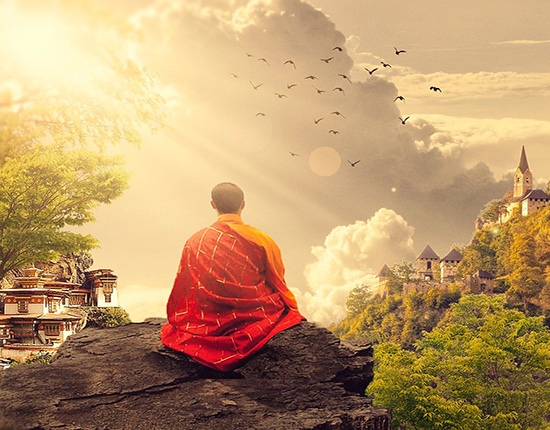Buddhist Tour Package
Duration : 06 Nights / 07 Days
Destinations : Delhi - Kaushambi - Kapilvastu - Sravasti - Sankisa – Kushinagar - Sarnath - Patna Vaishali - Bodh Gaya - Delhi
| Day | Place |
|---|---|
| Day 1 | Delhi |
| Day 2 | Kaushambi - Kapilvastu |
| Day 3 | Sravasti |
| Day 4 | Sankisa – Kushinagar |
| Day 5 | Sarnath |
| Day 6 | Patna Vaishali |
| Day 7 | Bodh Gaya |
Detailed Itinerary
Day 1
Our guide will receive from delhi airport or new delhi railway station. We will go to dehradun and stay hotel.
Mindrolling Monastery: Mindrolling Monastery Dehradun is an important destination for Buddhists and tourists interested in the history and culture of Tibetan Buddhism. Mindrolling Monastery is also home to a number of important Buddhist artifacts and relics, including the sacred bone relics of the Buddha and the sixth Dalai Lama. The monastery also has a large collection of Buddhist texts and manuscripts, including rare and ancient texts that are considered to be of great historical and cultural significance.
Day 2
Kaushambi: In addition to being a significant Buddhist pilgrimage site, Kaushambi is renowned for its rich cultural legacy and stunning natural surroundings. The city draws tourists from all over the world and is easily reachable from surrounding towns like Varanasi and Allahabad.Kaushambi is thought to have been a significant hub of the Buddha's teachings and has a long history that dates back to the Vedic era. It is reported that during his lifetime, Gautama Buddha made multiple trips to the city and even gave several significant talks there.
Kapilvastu: Kapilvastu is an important destination for Buddhists and tourists interested in the history and culture of ancient India. The city is located in a Piprahwa in Siddharthanagar district beautiful natural setting and offers visitors a glimpse into the rich history and heritage of Buddhism in the region.
Day 3
Sravasti: Some significant moments in the life of Gautama Buddha, including the well-known miracle of the numerous forms, are connected to Sravasti. Many significant Buddhist structures may be found in the city, including the Jetavana Monastery, which King Prasenajit constructed for Gautama Buddha and his students.Other important sites in Sravasti include the Ananda Bodhi Tree, which is believed to have been planted by Gautama Buddha's disciple Ananda, and the Angulimala Stupa, which is believed to contain the bones of the notorious bandit-turned-disciple, Angulimala.
Day 4
Sankisa: The Asokan Pillar and the Sankisa Stupa are just two of the significant Buddhist sites that can be found at Sankisa. The Sankisa Stupa is a huge building that is thought to house the Buddha's remains, while the Asokan Pillar is a stunning sandstone pillar that was allegedly built by the Mauryan monarch Ashoka in the third century BCE. Other important locations in Sankisa include the Lord Shiva-dedicated Shobhnath Temple, which is thought to have been constructed on the site of an old Buddhist monastery, and the Dharmachakra Stupa, a sizable, historic stupa that was constructed to honour the Buddha's teachings.
Kushinagar: Kushinagar is home to several important Buddhist sites, including the Mahaparinirvana Temple, which houses a beautiful statue of the reclining Buddha, and the Ramabhar Stupa, which is believed to contain the remains of the Buddha's mortal remains.Other important sites in Kushinagar include the Mathakaut Temple, which is believed to be the site where the Buddha delivered his last sermon, and the Wat Thai Temple, which is a beautiful temple complex built in the traditional Thai style.
Day 5
Sarnath: Several significant Buddhist temples and structures can be found in Sarnath, notably the Dhamek Stupa, a huge cylindrical structure that was constructed in the sixth century CE and has a height of nearly 43 metres. The Chaukhandi Stupa, Mulagandha Kuti Vihara, and the Ashoka Pillar, which is topped by a monument of four lions that has become an important national emblem of India, are further noteworthy locations. Sarnath is a small village located near the city of Varanasi in the northern Indian state of Uttar Pradesh. It is an important Buddhist pilgrimage site as it is where Gautama Buddha is said to have given his first sermon after attaining enlightenment.
Day 6
Patna Vaishali : Some major moments in the life of Gautama Buddha are connected to Vaishali. It was the location of the second Buddhist council, which was held after the passing of Gautama Buddha, as well as the birthplace of Amrapali, a well-known courtesan who later turned into a student of the Buddha. Many significant Buddhist sites can be found in the city, including the Relic Stupa, which is thought to house the Buddha's bones, and the Ananda Stupa, which is thought to have been constructed by the Lichchhavi clan to mark their meeting with the Buddha.
Nalanda: Nalanda was a Buddhist monastery and university, where students from all over India and other parts of the world came to study Buddhist philosophy, logic, mathematics, astronomy, medicine, and other subjects.
Day 7
Bodh Gaya: Bodh Gaya is a small town located in the state of Bihar in India. The Thai Monastery, the Japanese Temple, and the Tibetan Monastery are just a few of the significant Buddhist temples and monasteries that can be found in Bodh Gaya. Visitors can get a taste of the various cultural and religious traditions of Buddhism from all around the world at these monasteries.Bodh Gaya is home to the famous Mahabodhi Temple, which is a UNESCO World Heritage Site and one of the oldest brick temples in India. The temple complex includes the Bodhi Tree, under which Gautama Buddha is believed to have attained enlightenment. Buddhists and travellers interested in the history and culture of ancient India frequently travel to Bodh Gaya. The city draws tourists from all over the world and is easily reachable from neighbouring places like Patna.
End of Tour

